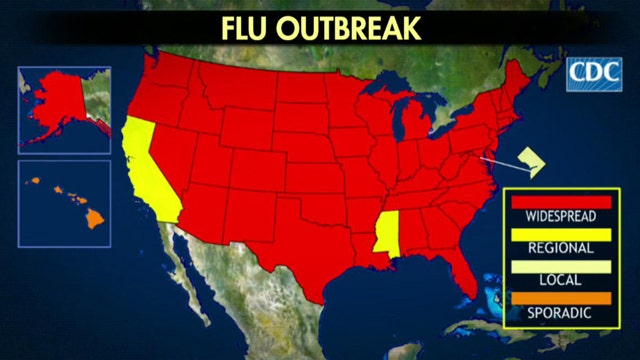Influenza has reached epidemic proportions in the United States, with 7.3 percent of deaths last week caused by pneumonia and the flu, the U.S. Centers for Disease Control and Prevention said Friday.
That is above the epidemic threshold of 7.2 percent, CDC said. Nine of the 10 regions of the United States had "elevated" flu activity, confirming that seasonal flu has spread across the country and reached high levels several weeks before the usual time of late January or February.
In addition, two more children have died this past week from flu-associated illnesses, bringing this season’s total to 20, the CDC said.
Public health authorities were correct in their forecast of which flu strains would emerge this season and therefore what vaccine to make – one against influenza A as well as influenza B. An
A strain, called H3N2, predominates this season, though the B strain has caused about 20 percent of cases.
"We have a good vaccine but not a great vaccine," Dr. Arnold Monto of the University of Michigan, a co-author of the vaccine-effectiveness study, said in an interview. "Every year we see vaccine failures."
Officials said while flu activity remains high in most states, some areas are actually seeing a decrease in activity, such as the South and Southeast, which were particularly hit hard early on in the season.
According to the agency, the proportion of outpatient visits for influenza-like illnesses (ILI) this past week was at 4.3 percent, which is still above the national baseline of 2.2 percent. New York City and 24 states are experiencing high ILI activity, and 16 states are reporting moderate ILI activity.
Since 47 states are reporting widespread flu activity, it is still urgent to get vaccinated if you have not yet received the flu shot. Those particularly at risk are children, senior citizens or those with an underlying health condition.
Last week, the agency said it is likely the increased flu activity will continue for a while. Based on the last 10 flu seasons, ILI remained at or above baseline for about 12 weeks – and up to 16 weeks during the 2005-2006 season. ILI remained above baseline for 19 weeks during the 2009 H1N1 pandemic.
Vaccine shortages
Officials said there may be a shortage of flu vaccines in some areas of the country. However, if you call around to different flu shot providers, you should be able to find a place that has the vaccine.
"People who haven't been vaccinated and want to get the vaccine may have to look in several places for it," said Tom Skinner, a spokesman for the CDC.
The vaccine remains the most effective form of prevention from the virus. Health officials said the vaccine is about 60 percent effective, and this year’s vaccine is well-matched to the viruses that are circulating.
Manufacturers projected 135 million doses of the vaccine, and 128 million doses were distributed as of the first week of January.
Doctors are recommending that if you start to see flu-like symptoms, including cough, fever and fatigue, you should start to take anti-virals immediately, and not wait for a positive test to come back.
Reuters contributed to this report.

